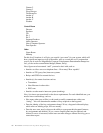
68 Handbook of Intercom Systems Engineering
buzz” audible in that audio signal. The data signal would not carry for as great of
distances. This type of error is second in the top ten of initial installation problems, after
addressing mistakes.
ADAM™ and ADAM™-CS systems are also available with other wiring schemes,
including multi-pin breakout to jackfields for monitoring and rapid changes and for use of
25 pair “Telco cable” for distribution. More information on this can be found in the
ADAM™ and ADAM™-CS System Installation manuals on the included CD.
Audio and Data Considerations
One of the benefits of the signal format described above is that generally, it does not
matter how the audio and data signals get from the keypanel to the matrix. If you want to
have a keypanel used in a Broadcast booth at the top of a football stadium which then is
connected to an ADAM™ matrix in the Sports Truck below, it is perfectly OK to have
prewired a small adapter to let you transport the three balanced signals (audio in, audio
out, and data) over three microphone cables in the audio harness which is already run
between the locations.
Also, if you want to “piggyback” the audio and data on an existing corporate WAN
running between two buildings on a campus, there should be no problem. The maker of
your WAN hardware, no doubt, has modules available for your system that let you feed
the balanced audio and data into an adapter that create appropriate format data to be
merged into the WAN data stream, thus, you have eliminated the need to install any
cables!
If you have “dark fiber” available to you, Telecast Fiber and others make adapters which
can take the audio and data, and run them down the fiber, even while running other audio,
video and data down the same fiber for other purposes.
Need to be able to “dial in” with a keypanel from a remote location to a matrix
somewhere? Multi-Tech and other modem manufacturers make voice over data modems
that can do the job. Intraplex and others make equipment that can take the voice and data
signals and send them via ISDN or switched 56.
Do both locations have bi-directional radio equipment? For example, satellite uplinks and
downlinks, microwave studio-transmitter links (STLs), or wideband full duplex two-way
radios. These will also work with appropriate modulators.
Again, with one possible concern, which is discussed in the next section, it does not matter
how you get the signals between keypanel and the matrix, simply that you do.
Polling Issues
Earlier, I mentioned one area of possible concern. In the examples I gave, where the
distance between matrix and keypanels is large, the transit time can become problematic.
If the distance is great enough, even the speed of light becomes a limiting factor.
Geo-synchronous satellites are 22,000 miles above the earth. To send a signal up to one,
and back down again will take on the order of a quarter of a second. To complete a round
trip will take half of a second (500 milliseconds), at best. You may have heard this
phenomenon on international telephone calls with your own voice coming back to you
greatly delayed. While the voice delay can be distracting, the delays in data are the real
problem. These data delays can become a problem even when the distance between the
matrix and keypanel is “only” 3,000 miles – because the encoders, modems, muxes, etc. in
that path also add delay; 30 milliseconds is typical.


















